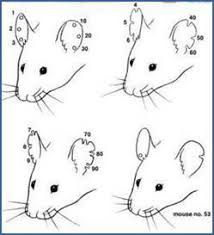We want to hear from you! Take the survey.
How do you use It’s Your Yale? How can it be improved? Answer for a chance to win Yale swag.
Rodent Identification and Genotyping
Revision Date:
April 14, 2021
Responsible Office:
Animal Research
Identification and genotyping of live transgenic animals is critical to the efficient pursuit of research and reducing the number of animals involved in a research project. For more specific details regarding the procedures below, refer to the associated policy.
Any of the individual procedures described below may be used as long as each is consistent with adequate veterinary care and the research model. These procedures do not cause more than momentary/transient pain or distress.
Procedure Preparation
1. As per Yale IACUC Policy Transportation of Animals (Intra), animals are transported to the room where the procedure will be performed.
2. The work space will be organized with all tools needed to minimize manipulation of the animal.
Procedures
Tail Biopsy
3. The rodent will be restrained manually or in an appropriate rodent restraint device, depending on the comfort level of the staff performing the procedure.
4. A local anesthetic may be used.
5. Using clean or new, sharp scissors or scalpel/razor blade, a maximum of 5mm of the distal end of the tail will be excised. If necessary, the tail may be cauterized to stop any bleeding.
6. The cutting device and other collection materials will be cleaned (e.g. alcohol or equivalent) between animals unless a single use blade is being used.
Ear Punch or Notch
7. The rodent will be restrained manually or in an appropriate rodent restraint device, depending on the comfort level of the staff performing the procedure.
8. A local anesthetic may be used.
9. Ear will be wiped with alcohol and allowed to dry before procedure.
10. The sharp ear punch device (scissors or blades are not permitted) will be placed in the desired location on the external ear of the rodent and pressed firmly through the ear. The device is carefully removed to not tear the ear.
 11. Rodents are identified with the numbers one through 99 by putting a hole, a notch, a double notch, or any combination of these three marks in one or both ears. The figure shows an example of a numbering system.
11. Rodents are identified with the numbers one through 99 by putting a hole, a notch, a double notch, or any combination of these three marks in one or both ears. The figure shows an example of a numbering system.
12. The cutting device and other collection materials will be cleaned (e.g. alcohol or equivalent) between animals unless a single use ear punch or blade is being used.
13. At a maximum, no more than two 3 mm in diameter ear punches per ear are permissible.
Toe Clipping
14. The rodent will be restrained manually or in an appropriate rodent restraint device depending on the comfort level of the staff performing the procedure.
15. Digit removal is limited to two toes per foot, and only two feet per animal (no more than 4 toes an animal).
16. Digit will be wiped with alcohol and allowed to dry before excising the digit.
17. Only half of the digit will be removed.
18. If the tissue collected will be used for genotyping, it will be saved for future analysis.
19. The cutting device and other collection materials will be cleaned (e.g. alcohol or equivalent) between animals unless a single use ear punch or blade is being used.
Post-Procedure Monitoring and Care
20. For all methods of identification or tissue collection, gentle but firm pressure is applied to the collection site until hemostasis has been achieved.
21. If significant damage was caused to the site of collection, contact VCS.
Acceptable Combinations of Genotyping and Identification
|
Primary genotyping method |
Permitted identification |
|---|---|
|
Blood collection |
|
|
Ear punch |
|
|
Toe clip |
|
|
Tail clip |
|


